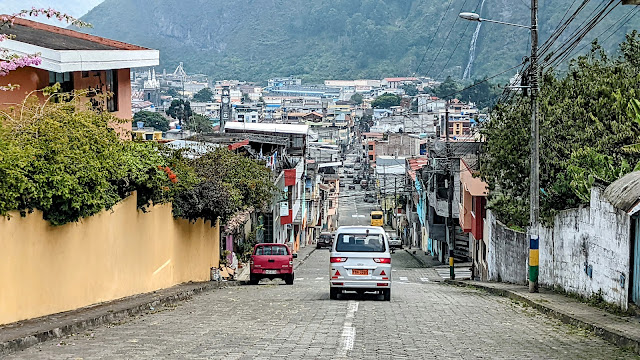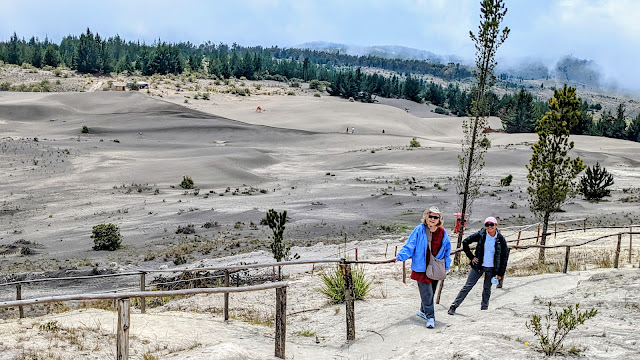Day 4: Parque Condor, Cayambe, and a Homestay
Today we left Quito and traveled to several towns to the northwest.
On our way out of Quito, we stopped and bought a Chirimoya, one of several unusual fruits we encountered in Ecuador. It was very sweet.
 |
| Patricia with a Chirimoya |
Our next stop was the town of Cayambe, which is the bizcocho capital of the world. A bizcocho is a buttery type of cookie, and the town is lined with places selling nothing but bizcochos. I can't say that I know what all of the fuss is about, but when in Cayambe, do as the Cayambeans do.
 |
| Workers making bizcochos |
 |
| Local tourist enjoying a bizcocho |
 |
| Lago San Pablo and Imbabura volcano |
Near Otavalo, we stopped at Parque Condor, a raptor sanctuary, where we witnessed a show with hawks, eagles and other large birds.
 |
| A hawk(?) at the sanctuary |
 |
| A bald eagle |
 |
| Another bald eagle |
 |
| A flower at Parque Condor |
For lunch, we ate at a very nice hacienda between Otavalo and Ibarra
 |
| At the hacienda |
After lunch, we stopped at the town of Peguche, where we visited a musical instrument maker and a weaving shop.
 |
| Instrument maker in Peguche |
 |
| Church and town square in Peguche |
From Peguche, we headed towards the town of Angochagua, near where we would spend the night.
 |
| I believe this is Cotacachi Volcano, which is 16,220 feet at the summit |
 |
| Scenery in the area of Angochagua |
We spent the night in a house in the Magdalena community, near Angochagua.
 |
| The house where we stayed |
 |
| One of the guest bedrooms. The heater was very handy as it got very cold |
 |
| The living room |
 |
| At the dining table |
The dinner was prepared by the wife and daughter of the owner of the house, and was excellent.
 |
| Our chefs |
 |
| A tamarillo, or Tree Tomato. Fortunately, it tastes nothing like a tomato. |
Day 5: Horseback Riding and Otavalo
 |
| At breakfast the next morning |
Before we left, we went for a short horseback ride, with the owner of the house and his daughter guiding us. The scenery was wonderful. This was the second time in my life I've been on a horse.
After our horseback rides, we drove to Laguna Cuicocha, a lake in a volcano caldera
 |
| Main plaza in Quiroga, a town near the lake. Every town in Ecuador had a sculpture with its name spelled out. |
 |
| Laguna Cuicocha |
From Laguna Cuicocha, we drove to Otavalo, a town famous for its craft market
 |
| On the way to Otavalo |
 |
| Main square in Otavalo |
 |
| Central Otavalo |
 |
| At the market |
 |
| More from the market |
 |
| Still more from the market |
From Otavalo, we headed back to Quito, where we spent the night.
Day 6: Baños and the Avenue of Volcanoes
From Quito, we headed south to Baños, passing through several towns on the "Avenue of the Volcanoes"
 |
 |
| Flowers for sale in the town of Tabacundo |
 |
| A farm and a volcanic peak |
 |
| Cotopaxi volcano (I think), the world's highest active volcano |
 |
| The town of Salcedo is famous for it's ice cream, so we were obligated to stop |
The town of Baños is famous for its thermal baths (which we didn't visit), and the waterfalls in the surrounding areas.
 |
| Entering Baños -- note waterfall under the streetlight |
 |
| A waterfall in the town |
 |
| In the main square. Church of the Holy Water is in the background |
 |
| A convent next to the church |
 |
| Barbecued guinea pig. I passed |
 |
| Another square in Baños |
 |
| Cascada el Manto de la Novia, one of many waterfalls in the area |
 |
| Some local flora |
 |
| View in the mountains outside of Baños |
 |
| Ice Cream with Cheese! mmmmm! |
 |
| View of Baños from the surrounding mountains |
 |
| Chimborazo volcano |
Eventually, we arrived in the town of Riobamba, where we stayed in a hacienda just outside of town.
 |
| Hacienca Abraspungo |
 |
| At the hacienda |
Day 7: Riobamba to Cuenca Along the Route of the Devil's Nose Train
Today we headed south from Riobamba, through several small towns.
 |
| On the streets of Riobamba |
The first town we passed through was Colta, which is noted for the first Catholic church in Ecuador, which was built in 1534.
 |
| A local crowd at the market in Colta |
 |
| Iglesia de Balbanera, in Colta |
 |
| In the town of Guamote |
 |
| More scenery for Guamote |
 |
| A church in Guamote |
Near Guamote, we encountered the Dunas de Arena in the Palmira Desert. This is an area of sand dunes in the middle of the mountains.
 |
| Brenda and Patricia in the desert |
 |
| More of the dunes |
 |
| There was a little restaurant at the dunes |
 |
| A bathroom (and water supply) at the dunes. Actually, it was clean, with a real toilet. |
Eventually we arrived in the town of Alausi for lunch. If we had taken the trip a few years ago, this would have been the starting point for the Devil's Nose Railway. This was considered to be the most dangerous (and one of the most spectacular) train trips in the world. Unfortunately, last year the Ecuadorean rail system went bankrupt, so the train no longer runs :-(
 |
| Central Alausi |
 |
| Where the Devil's Nose Train would have departed from |
 |
| Obligatory town name sculpture in Alausi |
 |
| That's 2 liters of beer for $2 (US) |
 |
| Street scene in Alausi |
 |
| Overview of Alausi |
We drove along the route of the Devil's Nose Train, but unfortunately, it got cloudy and foggy as soon as we left Alausi.
Eventually, we arrived in Cuenca to spend the night. Our hotel was in a 19th century building.
 |
| The outside of our hotel |
 |
| Inside the hotel |









